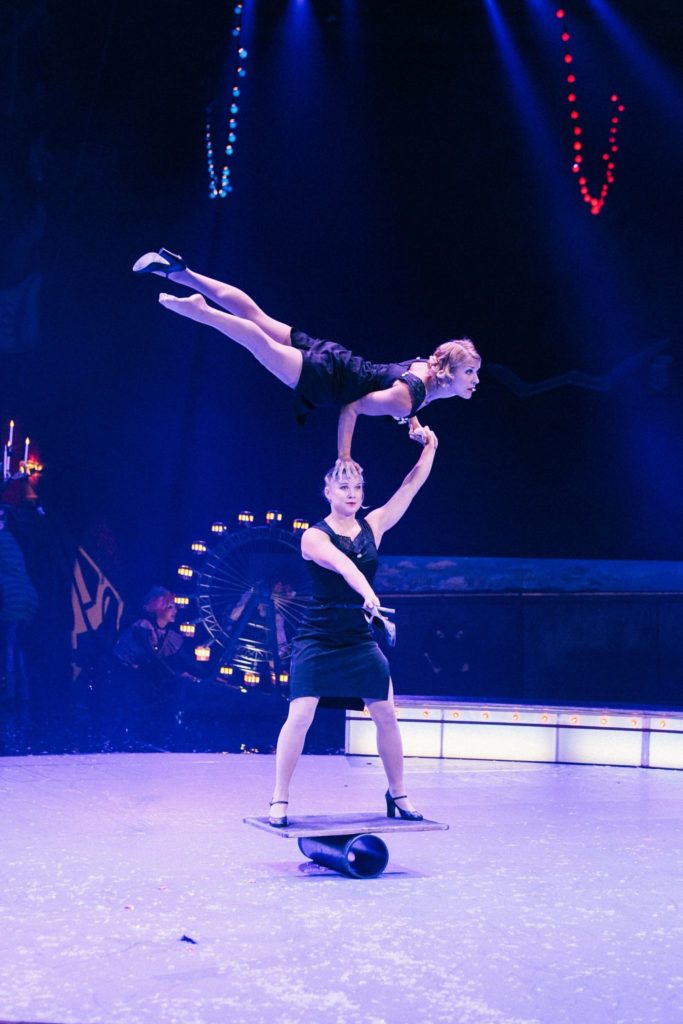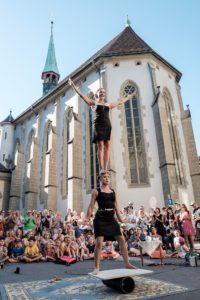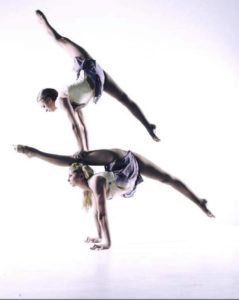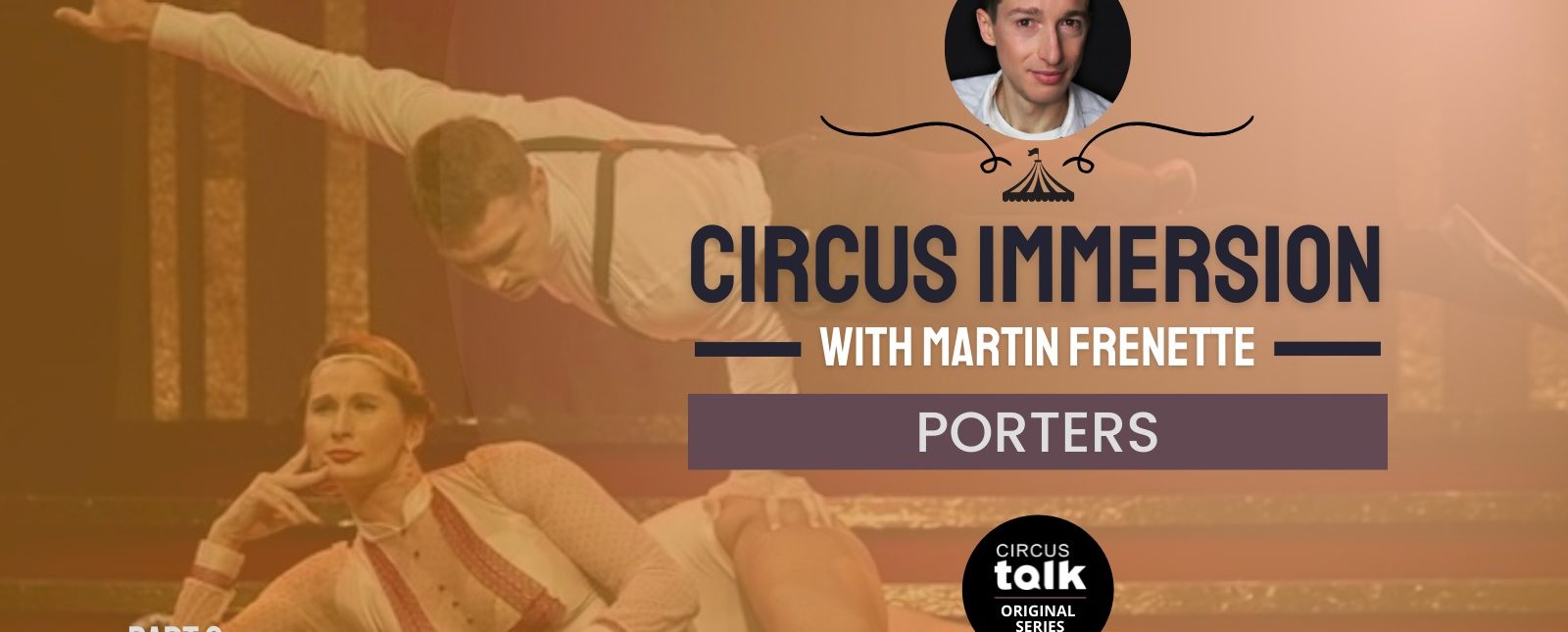Circus Immersion – Lights on Those in Their Flyer’s Shadow–Pro Exclusive
Human beings are conditioned to look up, our eyes instinctively go for the top. Tourists stare at a tower’s peak the same way an audience follows an acrobat’s ascent to the top of a pyramid. There is something fascinating about how high one gets for a triple salto– and in a flyer’s ability to seemingly defy gravity. Following movements and body attentively, the crowd bursts into applause when the artist succeeds. It sometimes feels like porters are forgotten, aren’t getting as much light, especially since limbs extended above their head are likely to cast a shadow on them. However, the nature of their role and the responsibilities they entail are definitely not a supporting character’s. Even if supporting their partner is what’s expected of them!
Trust best describes what hand to hand is about. Porters must therefore do what it takes to maintain their flyer’s. There is no room for doubt nor fear when one goes into a dynamic trick or intricate handstand. A sequence’s success depends on two individuals. They rely upon, depend on, and can influence each other. Consequently, porters make it a priority to give their flyer what they need at all times, whether it’s a strong grip or peace of mind.
In many ways, a porter’s duties are as physical as they are psychological. They look after their partner’s body by preventing any harm and giving the right balance of softness and rigidity positions require. “Bases” must also read minds and understand what limbs are saying. Only those truly connected to their partner can be a step ahead, anticipate their next move, and catch them before it’s too late. “It’s essential for a flyer to trust that their porter will be there no matter what. This partnership goes far beyond technique since one’s feelings can impact the other’s actions,” says Stina Kopra.

Born in Finland where nearly every kid attends youth circus at least once and where girls often outnumber boys, the 37-year old never saw size or gender as relevant pairing factors. A regular at traditional circuses where sisters and cousins often share the stage, the Finnish acrobat was not puzzled by her coach suggesting that she joins forces with Lotta, a girl who just quit trapeze after an arm injury. Inspired by a Russian couple they saw performing hand to hand on a rola bola, Lotta and Stina gained strength, balance, and confidence while investing in their partnership.

Having outgrown Sorin Sirkus youth’s program, the pair entered Brussels’ circus school with the aim of joining the professional industry before long. In spite of having successfully passed ESAC‘s audition, the two girls initially felt that many teachers and students had their doubts about them and doubled in efforts to be accepted by their peers and coaches. Hand to hand duos had always consisted of a man and a woman, the latter usually smaller and thinner than her porter. “We did not fit the mold and had no one’s path to follow. We had no choice but to figure things out by ourselves at first. We were sent to a hand to hand convention in Madrid where mixed couples were all working on the same dynamic tricks. We stood out as the only female duo who had been training differently since our first encounter,” adds Kopra.
One must know when to give the other space, whether this is the time for discussion or letting go.
Being as physically strong and stable as possible, having an innate desire to collaborate with and understand others are musts. A good porter listens more than they complain when things don’t go according to plan. “Openness and being able to talk about anything with your flyer are keys to a strong, lasting relationship. It really is like a marriage, with its ups and downs. One must know when to give the other space, whether this is the time for discussion or letting go. That is how you develop a mutual trust and strong connection” affirms the Finnish porter.
Following their coach’s suggestion of focusing on static elements that would be less damaging to their bodies and work well on the rola bola, the pair developed an act that felt very close to who they were. Their strong personalities were as featured as their muscles in their graduation piece. Inspired by their struggle to find a place in a male-dominated field and their own take on femininity, they imagined an act that highlighted their qualities as much as their flaws. Its creators are the first surprised that it still gets strong reactions wherever they perform. “We did not expect to present it beyond ESAC’s walls. This creation came from such a personal place that producers are still requesting it 13 years later. Spectators see us, two women, as who we are, with our strength and flaws. The strong emotions we still see on people’s faces sort of confirm that the piece is still relevant” concludes Kopra in a blend of pride and happiness.
Even though flyers and porters are expected to be equally grounded and as stable on their feet, the latter tend to have a stronger connection to the ground and a better understanding of how to use it. Often seen as stiffer than their partner, this misconception can be explained by the natural tension that takes over when their attention goes entirely to their flyer. There is a nervous aspect that tightens one’s muscles and makes them look not as swift or light as their limber partner. Audiences tend to get less involved with porters simply because their focus most often is on the person by them rather than on those watching. Such focus somewhat stops them from looking at and connecting with someone else other than their flyer. Luckily, there are those transitions and coming down moments where a porter can lock eyes with the crowd and show off their acting skills.
The connection uniting stage partners is the most important aspect of their act. Each has its role and neither is to blame when something goes wrong. They are two parts of a whole that share responsibilities when the lights go on. Both contribute to a performance’s success by giving the other what they need. “A porter and a flyer’s bond goes beyond the show too. Those who share more than just their work are likely to have a stronger one. Good off-stage time is as important as the act,” says Kopra before adding that each duo must find what works best for them.
A Tall Boy and Shorter Girl’s Chance Encounter
Both men and women seem to agree on what makes a happy acrobatic marriage since Mason Ames nearly quotes his Finnish colleague when asked about a porter’s musts.
“Openness. Definitely. For the rest, the same as in any relationship: compassion, consideration, and confidence. My relationship with my flyer is built on trust” explains the Ecole national de cirque (ENC) alumni, 15 years into his partnership with his flyer.

The two of them met at the school’s audition in 2006. Several youth circus courses had lit his inner porter’s spark and “tossing people around” had become second nature. He needed a flyer to move forward and she was a former gymnast in need of a porter. The tall boy and shorter girl decided to make it work, learning as much from each other as they did about one another. “We’re very close friends at times, more like colleagues at others, and we’ve managed to find a healthy balance over the years,” adds Ames.
Objects are predictable and don’t have a mind of their own, even though many affirm having a close relationship with their props or apparatus. Getting better at manipulating or dealing with an unanimated mass comes with more time, more training– that’s all. However, collaborative work such as hand to hand requires excellent communication. Physical training alone isn’t enough to help a partner excel at what they do. Energies must be in sync and have the same intention to reach a common goal. One can’t keep dropping their partner and tossing them back in the air as they’d do with a juggling club. Situations must be observed, issues have to be addressed, and both parties need to be on the same page to get over an obstacle.
Ames sees hand to hand as an expression of movement, relationship, space, and the dynamic of energy between two people. Porters support and manipulate their flyers in this energy exchange. Whether these grips and moves come out of love or force is always up for interpretation and some like to make the line as blurry as possible to keep the audience guessing.

Two humans can’t stop at a single emotional spectrum. The union of their energies, strengths, and flaws automatically broadens their artistic possibilities. There are trends and some acts convey some déjà-vu, but there are no two porters with the exact same relationship with their flyers, even if seemingly coming from the same mold to the outside eye. Sure, Mason and Val are closer than Lotta and Stina are to the general idea of an acrobatic pair: a tall, strong guy with a shorter, thinner girl. However, there’s a vulnerability factor that each duo faces when entering a creation phase, regardless of their sizes and genders. Neither can hide behind an apparatus nor use it to display their skills and emotions. Porters and flyers can only be who they are and express how they feel with the help of their better acrobatic ha
Since a porter’s attention most often is on their flyer, many develop a sixth sense when it comes to balance. The more time is spent finding habits and knowing their flyer’s, the better. The earlier one feels an unusual and unwanted tilt, the faster they can read and process the movement. A porter’s quick reaction time is a flyer’s safety net as they know their partner will do everything to prevent a fall or an injury. Porters either get their flyer back in their center or catch them. A quick look into the other’s eyes is enough for long-time partners who then make something on the spot or go to “plan B.”
“Career and the work partnership was the #1 priority. Now that I have a little one, priorities have been juggled around a bit” adds Ames.
Becoming a father forced the 34-year old to re-evaluate his priorities. Leaving France and the show that the pair was on to rejoin his little family in Quebec City was one of the hardest decisions he ever had to make. One that does not change his feelings towards his flyer, but that had to be made nevertheless. “I knew I had to put my family first. Val also is family on a certain level, but this is different. My child now comes first, followed by my partner, and my flyer comes right after,” concludes the proud father.
Flexible Porter or Strong Contortionist?
Tall boy meets girl, tall boy throws and catches girl… That’s an old circus story. How about tall girl bases boy? At 1.80 meters, Irina Bessonova has always towered above her flyer, male or female. Raised by a mother who always dreamed of running away with the circus, the naturally flexible toddler was enrolled in gymnastics classes from the moment she could walk. “She just wanted me to learn extraordinary movements. It didn’t matter if they were gymnastics or circus ones. I instantly fell in love with acro-sport and am thankful for the good genes that helped me tremendously,” explains the Ukrainian athlete.

She had a flyer’s flexibility and a porter’s height. Her remarkable strength and hand-balancing abilities caught her trainer’s eye who paired her with another girl. Feared by many in the competitive scene, Bessonova spent 11 years attending meets around the world. Together with her flyer, they won the title of acro-sport World Champions not once, not twice, but four times before trading stadiums for stages. Some of their tricks had never been seen before and the fact that they were performed by two women added to their uniqueness. Their original movement sequences and on-stage complicity appealed to the circus industry and marked the beginning of “Aphrodite’s daughters.” The duo was invited to Monte Carlo’s circus festival upon retiring from acro-sport. They were labeled as “hand to hand” in the youth category. It was a new name, but the same role for Bessonova. “I’m not a flexible porter nor a strong contortionist, I’m an acrobat! A circus artist with good genes, ” she nuances.
“Thankful” might be the word that best describes the 37-years old. She thanks life for the gifts it gave her and for the few flyers she has worked with. “Aphrodite’s daughters” indeed parted ways after rave reviews in dinner shows and European circuses. Using the same patience and diplomacy that contributed to her first duo’s success, this porter started basing men to explore other artistic avenues and stand out even more as a woman porting a man. Bessonova reckons that every porter should rely on these qualities to build a lasting bond with their flyer and fully enjoy each show, each act.
Her final “thanks” goes to the coach who gave her a good technique and taught her how to properly use her body. Infinite amounts of strength are not what makes a good porter. Having the tiniest flyer does not guarantee amazing feats. “A good porter has good technique, that’s all. You don’t need to be that strong if you’ve learned it well. Your technique will make you do it,” she concludes.

Three porters, three different approaches, two different genders, and yet many things in common. Listening to these two ladies and one gentleman, it is striking to hear how little they speak of what they need or want on stage. They discussed their flyer’s needs, their feelings, and the bond that unites the pair. In the same way that each always goes the extra length to keep their flyers in balance and put their needs before their own, Kopra, Ames, and Bessonova unconsciously did the same in their speech. Each put their flyer in the front seat, making them the answer to a porter’s question. A piece that was meant to be on porters might end up being more about flyers at a second glance. If so, the importance of openness and communication in a duo they each brought up is an undeniable must for both parties!
All photos provided courtesy of the artists via Martin Frenette. Feature photo. Photo credit: Irina & Andry...
Do you have a story to share? Submit your news story, article or press release.







